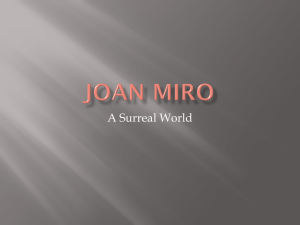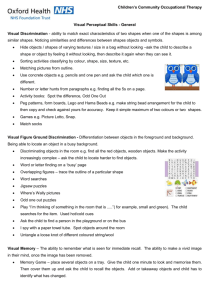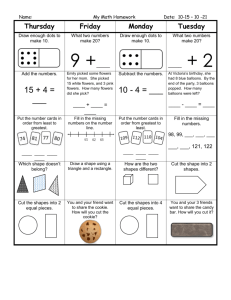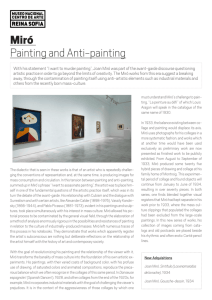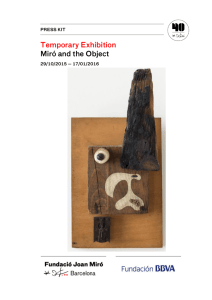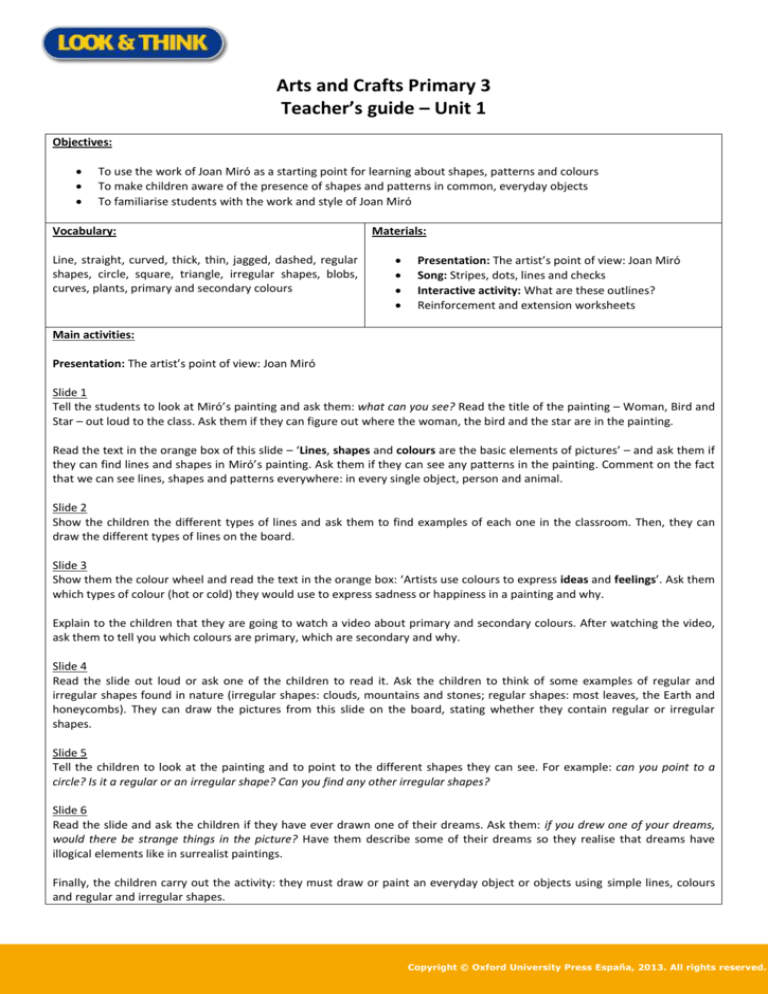
Arts and Crafts Primary 3
Teacher’s guide – Unit 1
Objectives:
To use the work of Joan Miró as a starting point for learning about shapes, patterns and colours
To make children aware of the presence of shapes and patterns in common, everyday objects
To familiarise students with the work and style of Joan Miró
Vocabulary:
Line, straight, curved, thick, thin, jagged, dashed, regular
shapes, circle, square, triangle, irregular shapes, blobs,
curves, plants, primary and secondary colours
Materials:
Presentation: The artist’s point of view: Joan Miró
Song: Stripes, dots, lines and checks
Interactive activity: What are these outlines?
Reinforcement and extension worksheets
Main activities:
Presentation: The artist’s point of view: Joan Miró
Slide 1
Tell the students to look at Miró’s painting and ask them: what can you see? Read the title of the painting – Woman, Bird and
Star – out loud to the class. Ask them if they can figure out where the woman, the bird and the star are in the painting.
Read the text in the orange box of this slide – ‘Lines, shapes and colours are the basic elements of pictures’ – and ask them if
they can find lines and shapes in Miró’s painting. Ask them if they can see any patterns in the painting. Comment on the fact
that we can see lines, shapes and patterns everywhere: in every single object, person and animal.
Slide 2
Show the children the different types of lines and ask them to find examples of each one in the classroom. Then, they can
draw the different types of lines on the board.
Slide 3
Show them the colour wheel and read the text in the orange box: ‘Artists use colours to express ideas and feelings’. Ask them
which types of colour (hot or cold) they would use to express sadness or happiness in a painting and why.
Explain to the children that they are going to watch a video about primary and secondary colours. After watching the video,
ask them to tell you which colours are primary, which are secondary and why.
Slide 4
Read the slide out loud or ask one of the children to read it. Ask the children to think of some examples of regular and
irregular shapes found in nature (irregular shapes: clouds, mountains and stones; regular shapes: most leaves, the Earth and
honeycombs). They can draw the pictures from this slide on the board, stating whether they contain regular or irregular
shapes.
Slide 5
Tell the children to look at the painting and to point to the different shapes they can see. For example: can you point to a
circle? Is it a regular or an irregular shape? Can you find any other irregular shapes?
Slide 6
Read the slide and ask the children if they have ever drawn one of their dreams. Ask them: if you drew one of your dreams,
would there be strange things in the picture? Have them describe some of their dreams so they realise that dreams have
illogical elements like in surrealist paintings.
Finally, the children carry out the activity: they must draw or paint an everyday object or objects using simple lines, colours
and regular and irregular shapes.
Copyright © Oxford University Press España, 2013. All rights reserved.
Song: Stripes, dots, lines and checks
Listen to the song and make the following movements when these words are sung:
What is that shape? Shrug your shoulders.
Make them with your hands: wave your hands in the air.
Stripes: draw straight, vertical lines in the air with both your hands.
Dots: make dots with your fingers in the air.
Lines: move your hand diagonally across your body.
Checks: form a square with the fingers of both hands and mark boxes in the air.
Encourage the children to mimic the movements.
Interactive activity: What are these outlines?
To begin the activity, tell the children to look at the different outlines. Ask them what colours they can see. Ask them if they
recognise any of the outlines of the animals.
Then, call four children up to the board to take turns doing the activity – there are five animals in the activity, but the last one
will be obvious if the previous four are guessed correctly. Each child clicks on an audio icon. After listening to the description
of the animal, they reveal a photo of that animal by clicking on its corresponding outline.
The rest of the class should try to guess the correct answer (without shouting it out), and be prepared to answer should the
student doing the activity answer incorrectly.
Closing activities:
Line mimicry game
The aim of this game is to reinforce the different types of line that have been covered in the PowerPoint presentation. Ask all
the children to stand up. Tell them that you will call out types of line, and that for each type they have to mime it with the
following gestures.
Straight lines: they draw a straight horizontal line in the air with one hand.
Curved line: they draw a curved line in the air with one hand.
Thick line: they use two hands to draw a thick line in the air.
Thin line: they use two hands to draw a thin line in the air.
Jagged line: they draw a jagged vertical line in the air with one hand.
Dashed line: they use one hand to draw a non-continuous, vertical line in the air.
Call out the types of line faster and faster. When one child gets it wrong he/she has to sit down. Do the activity until there are
no children still standing.
Fast finishers:
Draw one of your dreams imitating surrealist artists. Use
different types of lines and shapes, as well as plenty of
vibrant colours.
Language assistant:
They can help the teacher to explain the presentation and
ask the children about lines, shapes, colours, patterns and
their dreams.
They can also mime the actions of the song.
Finally, while the children are working, the assistant can
ask each child to briefly describe what he or she is doing.
Copyright © Oxford University Press España, 2013. All rights reserved.



